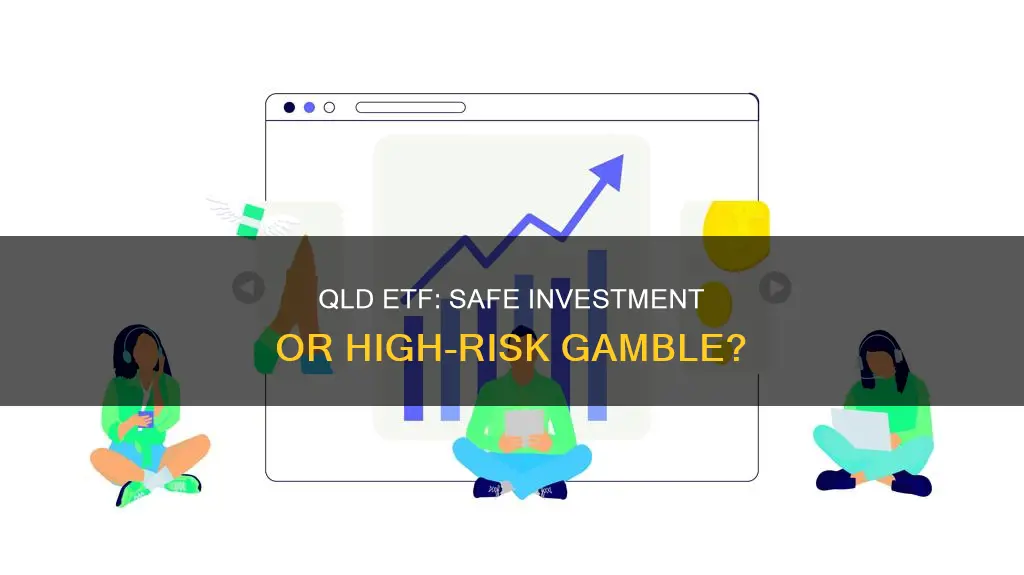
The QLD ETF is a leveraged exchange-traded fund designed to provide daily investment results that correspond to double the daily performance of the NASDAQ-100 Index. This means that if the NASDAQ-100 Index gains 1% on a given day, the QLD ETF aims to gain 2%. However, this leverage works both ways, making the QLD ETF a more volatile investment option. This volatility is further amplified when holding periods are longer than a day. The QLD ETF is, therefore, more suited for short-term trading rather than long-term holding. Before investing in the QLD ETF, it is important to carefully consider the associated risks and expenses, as well as one's risk tolerance and investment timeline.
| Characteristics | Values |
|---|---|
| Type of Investment | Exchange-traded fund (ETF) |
| Investment Objective | Designed to provide investment results that correspond to the daily investment return of the NASDAQ-100 Index |
| Investment Strategy | Leveraged ETF, aiming to double the daily return of the NASDAQ-100 Index |
| Risk Profile | Higher risk due to leveraged nature, more volatile than other investments, suitable for short-term trading rather than long-term holding |
| Benefits | Broad exposure to the tech sector, attractive for investors seeking higher short-term gains, liquidity |
| Performance | Average annual return of 28.5% since February 6, 2010; up 28.9% since January 1, 2020 |
| Costs | Management fees, expense ratio, and other associated costs |
| Prospectus | Available for download and print, recommended to read carefully before investing |
What You'll Learn

QLD ETF's volatility and risk
The QLD ETF is a leveraged exchange-traded fund designed to provide investment results that correspond to double the daily return of the NASDAQ-100 Index. This means that if the NASDAQ-100 Index gains 1% on a given day, the QLD ETF aims to gain 2%. However, this leverage also works in the opposite direction, so a 1% loss in the NASDAQ-100 Index would result in a 2% loss for the QLD ETF. This inherent volatility makes the QLD ETF a riskier investment compared to non-leveraged ETFs.
The leveraged nature of the QLD ETF makes it more suitable for short-term trading rather than long-term holding. Investors in the QLD ETF should carefully consider their risk tolerance and investment timeline. While the potential for higher short-term gains is attractive, the volatility of the fund can also lead to significant losses. Compounding can cause a widening differential between the performances of the QLD ETF and the NASDAQ-100 Index, and aggressive investment techniques can further increase volatility and decrease performance.
The QLD ETF provides exposure to a broad spectrum of the tech industry, including technology, telecommunications, retail, health care, and biotechnology companies. This diversification can help to mitigate some of the risks associated with investing in individual stocks. However, it is important to note that the tech sector is inherently more volatile than other sectors, and the performance of the QLD ETF is closely tied to the performance of the tech sector.
To make informed investment decisions, it is crucial to carefully review the prospectus of the QLD ETF, including investment objectives, risks, charges, and expenses. The Morningstar Rating provides a risk-adjusted performance assessment, considering downward variations and rewarding consistent performance. Additionally, investors should be mindful of their overall investment strategies and risk management approaches.
Manufacturing's Financial Risks: Exploring Investment Pitfalls
You may want to see also

How the leveraged nature of the QLD ETF works
The QLD ETF is an exchange-traded fund (ETF) that provides investors with exposure to a specific sector, in this case, the technology sector. It aims to track the performance of the NASDAQ-100 Index, which includes 100 of the largest non-financial companies listed on the NASDAQ stock exchange. By investing in the QLD ETF, individuals can gain exposure to a diverse range of technology companies without having to purchase shares in each company individually.
The leveraged nature of the QLD ETF means that it aims to provide double the daily return of the NASDAQ-100 Index. So, if the NASDAQ-100 Index gains 1% on a given day, the QLD ETF aims to gain 2%. However, it's important to note that this leverage works both ways. If the NASDAQ-100 Index falls by 1%, the QLD ETF aims to fall by 2%. This leveraging aspect makes the QLD ETF a more volatile investment compared to non-leveraged ETFs.
The QLD ETF's structure allows investors to place bets on the short-term movements of the technology sector. It is designed for short-term investing rather than long-term holding due to its leveraged nature. The QLD ETF provides a straightforward way to gain exposure to the technology sector and potentially realise significant gains. However, the inherent volatility of the investment necessitates a well-informed approach before committing.
When considering investing in the QLD ETF, it is crucial to understand the risks involved. Leveraged ETFs, such as the QLD, amplify the daily returns of an index or stock using financial derivatives. This means that they can be more sensitive to market movements and may underperform during trading range markets. Additionally, investors should consider the expense ratio and other associated costs, as these can impact the potential gains from the investment.
In summary, the leveraged nature of the QLD ETF provides the potential for higher short-term gains by aiming to double the daily returns of the NASDAQ-100 Index. However, it is a more volatile investment due to the magnified impact of market movements. Investors considering the QLD ETF should carefully weigh the risks and ensure they have a clear understanding of how leverage works before investing.
Savings vs. Investments: Understanding the Key Differences
You may want to see also

The suitability of the QLD ETF for short-term vs long-term investment
The QLD ETF is a leveraged exchange-traded fund designed to provide investment results that correspond to double the daily return of the NASDAQ-100 Index. This makes the QLD ETF a more volatile investment option compared to non-leveraged ETFs. The fund encompasses a wide range of tech companies, enabling investors to gain exposure to the technology sector's performance.
Given its leveraged structure, the QLD ETF is more suitable for short-term trading rather than long-term holding. Leveraged ETFs are designed for short-term investing tactics, aiming to capitalise on daily market moves. If the market moves in the desired direction, the QLD ETF can yield significant gains. However, investors must be prepared to exit quickly if the market turns unfavourable.
For example, during the mortgage meltdown in 2008, holding a 2x leveraged NASDAQ-100 fund resulted in significant losses. Similarly, during the dot-com bubble burst, a leveraged fund would have amplified the NASDAQ index's losses. These events highlight the risks associated with leveraged ETFs in the long term.
On the other hand, the QLD ETF's ability to double the daily returns of the NASDAQ-100 Index makes it attractive for short-term gains. Investors seeking to profit from short-term movements in the tech sector may find the QLD ETF appealing. Additionally, the QLD ETF provides a simple way to gain broad exposure to the tech sector without needing to purchase shares in every NASDAQ-100 company individually.
In summary, the QLD ETF is more suitable for short-term investing due to its leveraged nature. While it offers the potential for substantial short-term gains, it also carries the risk of amplifying losses during market downturns. For long-term stability and growth, diversified investments like the QQQ or VOO funds are generally recommended over leveraged ETFs.
Building a Socially Responsible Investment Portfolio: Doing Well by Doing Good
You may want to see also

The QLD ETF's performance and past returns
The QLD ETF is designed to provide investment results that correspond to the daily investment return of the NASDAQ-100 Index. It aims to provide double the return of the NASDAQ-100 on a daily basis. This means that if the NASDAQ-100 Index gains 1% on a given day, the QLD ETF aims to gain 2%. However, this leverage also works in the opposite direction, meaning that if the NASDAQ-100 falls by 1%, the QLD ETF aims to fall by 2%.
The QLD ETF's performance is also compared to other indices and funds. For example, it has outperformed the S&P 500 by over 10% year-to-date as of the week of the U.S. presidential inauguration. Additionally, the QLD ETF has provided returns of +40% since the June lows in the stock market.
However, it is important to note that the QLD ETF's performance can be volatile due to its leveraged nature. This volatility is further amplified during market downturns, as seen during the mortgage meltdown in 2008, where a 2x leveraged Nasdaq-100 fund resulted in significant losses.
The QLD ETF's past returns and performance highlight the potential for significant gains, but also the risks associated with its leveraged structure. It is crucial for investors to carefully consider their risk tolerance, investment timeline, and the inherent volatility of the QLD ETF before making investment decisions.
Wealth Managers: Where Do They Invest Your Money?
You may want to see also

The expense ratio and other associated costs of the QLD ETF
The expense ratio and other associated costs of an investment are important factors to consider when assessing its suitability. The QLD ETF is a leveraged exchange-traded fund, designed to provide daily investment returns that correspond to double the daily performance of the NASDAQ-100 Index. This leveraged structure makes the QLD ETF a volatile investment option, and investors should carefully consider the associated costs and risks before investing.
The QLD ETF's expense ratio is not publicly available, but it is essential to monitor this ratio as it can impact the potential gains from the investment. The fund's prospectus or offering documents may provide more detailed information on the expense ratio and other fees. These documents outline the management and operational costs associated with the fund, which are typically covered by investors through the expense ratio.
One of the critical associated costs of the QLD ETF is the impact of high portfolio turnover. The fund has a trailing dividend yield of 0.24%, which is below the category average of 2.06%. High portfolio turnover can lead to higher expenses and lower after-tax returns, affecting the overall performance of the investment. Therefore, investors should carefully analyse the fund's historical turnover rate and assess the potential impact on their returns.
Additionally, investors should be aware of the potential costs related to the fund's investment strategy. The QLD ETF's strategy involves tracking the performance of the NASDAQ-100 Index and providing exposure to the tech sector. This strategy may incur costs associated with rebalancing the portfolio to align with the index's performance and maintaining exposure to the targeted sector. These costs can include transaction fees, brokerage commissions, and potential capital gains taxes when the fund realises profits.
It is also worth noting that leveraged ETFs, such as the QLD ETF, may have unique cost structures due to their use of financial derivatives to amplify returns. These derivatives can carry their own set of costs, including margin requirements, borrowing fees, and the potential for higher trading expenses. Therefore, investors should carefully review the fund's prospectus or offering documents to understand the full scope of costs associated with the QLD ETF's leveraged structure.
UK Private Equity: A Guide to Getting Started
You may want to see also
Frequently asked questions
The QLD ETF is an exchange-traded fund designed to provide investment results that correspond to the daily investment return of the NASDAQ-100 Index. It seeks to provide double the return of the NASDAQ-100 on a daily basis.
The leveraged nature of the QLD ETF makes it a more volatile investment compared to a non-leveraged ETF. It is designed for short-term investing tactics and requires active management, making it a risky and inconsistent investment option. Investors should carefully consider the risks, charges, and expenses outlined in the fund prospectus before investing.
Investing in the QLD ETF provides a simple way to gain broad exposure to the tech sector without having to buy shares in every company listed on the NASDAQ-100. The leveraged return potential is attractive to investors seeking higher short-term gains. Additionally, the liquidity provided by being an ETF makes it easy to buy and sell shares during regular trading hours.







